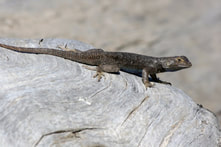 Western Fence Lizard sunning on a log. Photo Credit: K. Fitzgerald via Truckee River Guide Western Fence Lizard sunning on a log. Photo Credit: K. Fitzgerald via Truckee River Guide If you’ve been out and about recently you’ve probably noticed that the lizards and snakes are back out. Reptiles are ectotherms, which means they get body heat (aka energy) from outside forces, like the sun. Unlike plants, they can’t make their food out of this sunlight, but the heat activates their bodies to process food into energy and nutrients. That’s why you see lizards sitting on rocks in the sun; they’re getting ready for the day! In contrast, humans, and all other mammals, are endotherms, which means we use our food to create body heat. Because of this, mammals can still be active in the winter when it’s very cold and there is little heat from the sun available, but reptiles don’t do very well. When it’s cold, reptiles are very slow and therefore vulnerable to predators and have a hard time catching prey. So, most reptiles spend the winter in burrows underground. Although many reptiles are solitary creatures, the winter is a time when they group up and share burrows, generally all of the same species. Similar to hibernation, they slow their metabolism to almost nothing, just enough to keep them alive. When it warms up, they will exit their burrows and begin another season of slithering, scurrying, and sunning.
0 Comments
Leave a Reply. |
AuthorThis blog is managed by the staff and volunteers of Galena Creek Visitor Center. We write about parts of the natural world that we find fascinating and want to teach others about, as well as keeping you updated on the Visitor Center and park. If you want to learn more, please sign up for our monthly newsletter, where we share upcoming events, updates on the ecology of the park, and highlights from each month. Archives
October 2021
Categories |
 RSS Feed
RSS Feed
